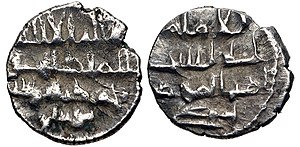Musa ibn Yahya (Arabic: موسى بن يحيى, romanized: Mūsā ibn Yaḥyā) was a member of the powerful Barmakid family in the service of the Abbasid Caliphate.
Musa ibn Yahya | |
|---|---|
 Coinage of Musa ibn Yahya al-Barmaki as governor of Sindh (c. AH 218–221 (833–836 CE) | |
| Abbasid governor of Syria | |
| In office 792 – 792 (less than a year) | |
| Monarch | Harun al-Rashid |
| Preceded by | Musa ibn Isa ibn Musa al-Hashimi |
| Succeeded by | Abd al-Malik ibn Salih |
| Abbasid governor of Sindh | |
| In office 831–835 | |
| Monarchs | Al-Ma'mun Al-Mu'tasim |
| Preceded by | Ghassan ibn Abbad |
| Succeeded by | Imran ibn Musa ibn Yahya |
| Personal details | |
| Born | Abbasid Caliphate |
| Died | c. 835 Sind, Abbasid Caliphate (now Sindh province of Pakistan) |
| Children | Imran (son) |
| Parent |
|
Life
editMusa was a son of Yahya ibn Khalid. He was not as prominent as his brothers Ja'far and al-Fadl, but was well known for his bravery in battle.[1] He served as governor of Syria in 792, to suppress the Qays–Yaman conflict in the province.[1][2][3] In 802, he was denounced to Caliph Harun al-Rashid by the governor of Khurasan, Ali ibn Isa ibn Mahan, as planning to raise the province in revolt against the Caliph. According to a report relayed by al-Tabari, at the same time Musa had to go into hiding from his debtors, so the Caliph became suspicious that he was about to secretly go to Khurasan; when Musa appeared before the Caliph, he had him arrested, and released only after his father vouchsafed for him.[4]
When the Barmakids were deposed and arrested by Caliph Harun al-Rashid in 803, Musa too was imprisoned with his father and brothers until the accession of al-Amin, who released them and showed them again some favour.[1] During the Fourth Fitna, Musa sided with al-Amin, fighting in the ranks of the loyalist army against al-Ma'mun, but he later entered the latter's service.[1] Al-Ma'mun appointed him as governor of Sindh. Musa died in office in 835, and was succeeded by his son, Imran.[1][2]
A grandson of Musa, Ahmad ibn Ja'far, surnamed Jahza, was one of the closest companions of the 10th century Caliph al-Muqtadir (r. 908–932).[1]
Family tree
edit
| ||||||||||||||||||||||||||||||||||||||||||||||||||||||||||||||||||||||||||||||||||||||||||||||||||||||||||||||||||||||||||||||||||||||||||||||||||||||||||||||||||||||||||||||||||||||||||||||||||||||||||||||||||||||||||||||||||||||||||||||||||||||||||||||||||||||||||||||||||||||||||||||||||||||||||||||||||||||||||||||||||||||||||||||||||||||||||||||||||||||||||||||||||||||||||||||||||||||||||||||||||||||||||||||||||||||||||||||||||||||||||||||||||||||||||||||||||||||||||||||||||||||||||||||||||||||||
References
edit- ^ a b c d e f Barthold & Sourdel 1960, p. 1036.
- ^ a b Crone 1980, p. 177.
- ^ Bosworth 1989, pp. 132–134.
- ^ Bosworth 1989, pp. 212–213.
Sources
edit- Barthold, W. & Sourdel, D. (1960). "al-Barāmika". In Gibb, H. A. R.; Kramers, J. H.; Lévi-Provençal, E.; Schacht, J.; Lewis, B. & Pellat, Ch. (eds.). The Encyclopaedia of Islam, Second Edition. Volume I: A–B. Leiden: E. J. Brill. pp. 1033–1036. doi:10.1163/1573-3912_islam_COM_0099. OCLC 495469456.
- Bosworth, C. E., ed. (1989). The History of al-Ṭabarī, Volume XXX: The ʿAbbāsid Caliphate in Equilibrium: The Caliphates of Mūsā al-Hādī and Hārūn al-Rashīd, A.D. 785–809/A.H. 169–192. SUNY Series in Near Eastern Studies. Albany, New York: State University of New York Press. ISBN 978-0-88706-564-4.
- Crone, Patricia (1980). Slaves on Horses: The Evolution of the Islamic Polity. Cambridge: Cambridge University Press. ISBN 0-521-52940-9.